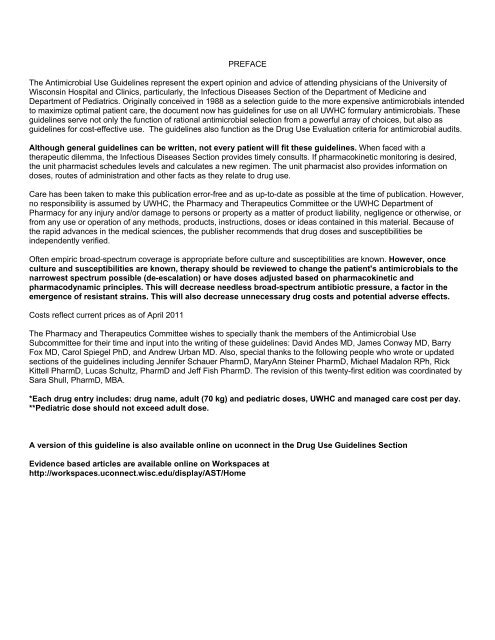Antimicrobial Use Guidelines (AMUG) version 21 - UW Health
Antimicrobial Use Guidelines (AMUG) version 21 - UW Health
Antimicrobial Use Guidelines (AMUG) version 21 - UW Health
Create successful ePaper yourself
Turn your PDF publications into a flip-book with our unique Google optimized e-Paper software.
PREFACEThe <strong>Antimicrobial</strong> <strong>Use</strong> <strong>Guidelines</strong> represent the expert opinion and advice of attending physicians of the University ofWisconsin Hospital and Clinics, particularly, the Infectious Diseases Section of the Department of Medicine andDepartment of Pediatrics. Originally conceived in 1988 as a selection guide to the more expensive antimicrobials intendedto maximize optimal patient care, the document now has guidelines for use on all <strong>UW</strong>HC formulary antimicrobials. Theseguidelines serve not only the function of rational antimicrobial selection from a powerful array of choices, but also asguidelines for cost-effective use. The guidelines also function as the Drug <strong>Use</strong> Evaluation criteria for antimicrobial audits.Although general guidelines can be written, not every patient will fit these guidelines. When faced with atherapeutic dilemma, the Infectious Diseases Section provides timely consults. If pharmacokinetic monitoring is desired,the unit pharmacist schedules levels and calculates a new regimen. The unit pharmacist also provides information ondoses, routes of administration and other facts as they relate to drug use.Care has been taken to make this publication error-free and as up-to-date as possible at the time of publication. However,no responsibility is assumed by <strong>UW</strong>HC, the Pharmacy and Therapeutics Committee or the <strong>UW</strong>HC Department ofPharmacy for any injury and/or damage to persons or property as a matter of product liability, negligence or otherwise, orfrom any use or operation of any methods, products, instructions, doses or ideas contained in this material. Because ofthe rapid advances in the medical sciences, the publisher recommends that drug doses and susceptibilities beindependently verified.Often empiric broad-spectrum coverage is appropriate before culture and susceptibilities are known. However, onceculture and susceptibilities are known, therapy should be reviewed to change the patient's antimicrobials to thenarrowest spectrum possible (de-escalation) or have doses adjusted based on pharmacokinetic andpharmacodynamic principles. This will decrease needless broad-spectrum antibiotic pressure, a factor in theemergence of resistant strains. This will also decrease unnecessary drug costs and potential adverse effects.Costs reflect current prices as of April 2011The Pharmacy and Therapeutics Committee wishes to specially thank the members of the <strong>Antimicrobial</strong> <strong>Use</strong>Subcommittee for their time and input into the writing of these guidelines: David Andes MD, James Conway MD, BarryFox MD, Carol Spiegel PhD, and Andrew Urban MD. Also, special thanks to the following people who wrote or updatedsections of the guidelines including Jennifer Schauer PharmD, MaryAnn Steiner PharmD, Michael Madalon RPh, RickKittell PharmD, Lucas Schultz, PharmD and Jeff Fish PharmD. The revision of this twenty-first edition was coordinated bySara Shull, PharmD, MBA.*Each drug entry includes: drug name, adult (70 kg) and pediatric doses, <strong>UW</strong>HC and managed care cost per day.**Pediatric dose should not exceed adult dose.A <strong>version</strong> of this guideline is also available online on uconnect in the Drug <strong>Use</strong> <strong>Guidelines</strong> SectionEvidence based articles are available online on Workspaces athttp://workspaces.uconnect.wisc.edu/display/AST/Home
















